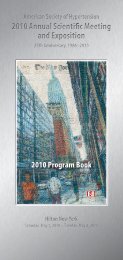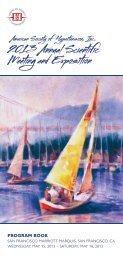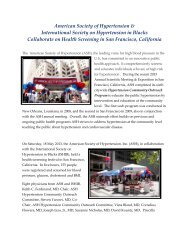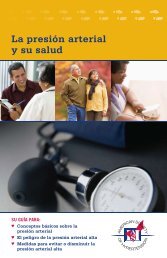2011 ASH Program Book - American Society of Hypertension
2011 ASH Program Book - American Society of Hypertension
2011 ASH Program Book - American Society of Hypertension
Create successful ePaper yourself
Turn your PDF publications into a flip-book with our unique Google optimized e-Paper software.
Special Lecture<br />
Monday, May 23, <strong>2011</strong>, 1:30 PM – 4:00 PM • East Ballroom • Third Floor<br />
Robert Tigerstedt Award Lecture<br />
Oscar A. Carretero, MD, F<strong>ASH</strong><br />
Oscar A. Carretero, MD was born in<br />
Mendoza, Argentina and received his<br />
degree from the School <strong>of</strong> Medicine at the<br />
University <strong>of</strong> Cuyo, Mendoza, Argentina.<br />
Dr. Carretero has contributed greatly to<br />
our understanding <strong>of</strong> the role <strong>of</strong> vasoactive<br />
hormones in the regulation <strong>of</strong> blood<br />
pressure and renal function, as well as the<br />
pathogenesis <strong>of</strong> hypertension and target<br />
organ damage (TOD). His research has<br />
resulted in over 360 publications. His<br />
fundamental contributions began with<br />
his initial hypothesis in 1972 that renal<br />
kinins may be involved in the regulation<br />
<strong>of</strong> sodium and water excretion, acting as natriuretic and diuretic hormones.<br />
His work has contributed uniquely to the understanding <strong>of</strong> the<br />
role <strong>of</strong> the renal kallikrein-kinin system, ranging from the development<br />
<strong>of</strong> methods to measure the components <strong>of</strong> the system and its localization<br />
to demonstrating that the renal kallikrein-kinin system is natriuretic and<br />
diuretic not only in high mineralocorticoid situations but also in the basal<br />
state. This work culminated with the demonstration that animals lacking<br />
the main kinin receptor (B2) develop hypertension when they are fed a<br />
high sodium diet. As a pioneer in the field <strong>of</strong> kinin research, where his<br />
contributions have been fundamental, numerous, and <strong>of</strong> high quality,<br />
we now understand that kinins act as paracrine hormones, regulating<br />
organ blood flow and renal function, and also participate on the chronic<br />
cardiovascular protective effect <strong>of</strong> angiotensin-converting enzyme (ACE)<br />
and angiotensin resector blockers. He and his colleagues demonstrated<br />
that kallikrein in the kidney is produced mainly in the connecting tubule<br />
(CNT) and in collaboration with Luciano Barajas they demonstrated that<br />
the CNT returns to the glomerulus and makes contact with the afferent<br />
arteriole. Recently he demonstrated that there is a crosstalk between the<br />
CNT and the afferent arteriole, showing that when sodium is increased<br />
in the perfusate <strong>of</strong> the CNT, the afferent arteriole dilates. They call this<br />
cross talk between the CNT and the afferent arteriole connecting tubuloglomerular<br />
feedback. This seminal contribution explains why during<br />
a sodium load, renal blood flow increases.<br />
Recently he has made another seminal contribution by demonstrating<br />
that the endogenous tetrapeptide N-Acetyl-Ser-Asp-Lys-Pro (Ac-SDKP);<br />
that is destroyed mainly by ACE; has anti-inflammatory and anti-fibrotic<br />
effects, and also contributes to the cardiovascular and renal protective effect<br />
<strong>of</strong> ACE inhibitors. Furthermore, he discovered that the enzyme prolyl<br />
oligopeptidase is involved in the release <strong>of</strong> Ac-SDKP from the protein<br />
thymosin β-4. He has shown that inhibition <strong>of</strong> this enzyme promotes<br />
vascular and renal fibrosis. He and his group have demonstrated that<br />
this peptide inhibits fibrosis by a) decreasing inflammation, b) fibroblast<br />
proliferation and collagen synthesis, c) TGF expression and d) its TGF<br />
signaling (Smad phosphorylation).<br />
20<br />
continued…









